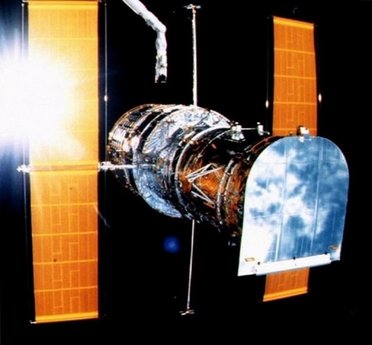 |
|
File photo of the Hubble Space Telescope. Astronomers around the world this weekend mark the 20th anniversary of the launching of the iconic Hubble.(Agencies) |
|
Astronomers around the world last weekend marked the 20th anniversary of the launching of the iconic Hubble, NASA's first orbiting space telescope that has revolutionized human understanding of the universe. More than any other instrument, the Hubble has stimulated a modern-day infatuation with deep space, beaming to Earth the most spectacular images ever taken of faraway galaxies and the births and deaths of stars -- and along the way helping scientists make some of the most important discoveries of our time. Hubble was launched aboard space shuttle Discovery on April 24, 1990 and deployed into orbit the following day. Piloting the shuttle on that historic mission was astronaut Charles Bolden, who went on to become the US space agency's administrator last year. In the two decades since, Hubble has enabled astronomers to peer through the celestial curtain to set the age of the universe at 13.7 billion years old. "Hubble is undoubtedly one of the most recognized and successful scientific projects in history," said Ed Weiler, associate administrator for NASA's Science Mission Directorate. From its unique perch some 570 kilometers (353 miles) above Earth, the telescope is our eye on the cosmos, snapping pictures of more than 30,000 celestial objects, some of them located on the far ends of the universe. The quality of Hubble images is 10 times clearer than pictures from the most powerful ground-based telescopes, because it is beyond the Earth's atmosphere, which distorts the view of ground telescopes. "It's that extreme clarity that gives us the feeling we've traveled out into space to see these objects," said Jon Grunsfeld, an astronaut who did repair work on Hubble during two shuttle missions. "It really is our time machine." Its successor is the James Webb Space Telescope, an infrared optimized space observatory scheduled to be deployed in 2014. (Read by Nelly Min. Nelly Min is a multimedia journalist at the China Daily Web site.) (Agencies) |
上周末,世界各地的天文学家庆祝哈勃太空望远镜发射升空20周年。这一由美国宇航局发射的首架标志性轨道太空望远镜让人类对宇宙的认识发生了革命性改变。 哈勃望远镜超越了之前的其它各种天文观测设备,激发了现代人探索外太空的兴趣。哈勃望远镜在服役期间向地球传回迄今所拍摄到的最为壮观的遥远星系的画面以及星星的诞生和陨灭等图像。它还帮助科学家做出了当今最重要的一些发现。 哈勃望远镜于1990年4月24日由”发现号“航天飞机携载发射升空,并在第二天进入轨道运行。 驾驶航天飞机完成这次历史性任务的宇航员名叫查尔斯•博尔登,此人于去年出任美国宇航局局长。 20年来,天文学家凭借哈勃望远镜提供的天体观测数据,测算出宇宙的年龄为137亿年。 美国宇航局科学任务委员会副主席艾德·维勒说:“哈勃太空望远镜无疑是史上最受认可、最为成功的科学项目之一。 哈勃望远镜地处地球上空约570公里(353英里)处,被视为人类探测宇宙的“眼睛”。目前,它已拍摄到三万多个天体的照片,其中一些天体远在宇宙尽头。 哈勃望远镜所拍摄照片的质量比功能最强大的地面望远镜所拍摄的照片还要清晰十倍,这是因为它处在地球大气层以外,而大气层会使地面望远镜拍摄的图像失真。 曾两次前往太空对哈勃望远镜进行维修的宇航员乔恩•格伦斯菲尔德说:“正是由于图像超级清晰,才使我们有种亲临太空的感觉。” “它堪称我们的时间机器。” 哈勃望远镜的”接班人“将是一架詹姆斯•韦伯太空望远镜。这架望远镜计划于2014年发射,是一套红外线优化太空观测系统。 相关阅读 Hubble telescope gets new life (中国日报网英语点津 Julie 编辑蔡姗姗) |
|
Vocabulary: infatuation:a foolish, unreasoning, or extravagant passion or attraction(醉心,着迷) deep space:space beyond the limits of the solar system(外太空,指太阳系以外的空间) |
